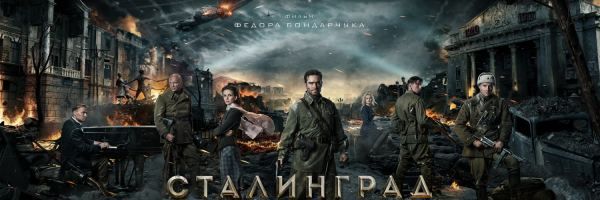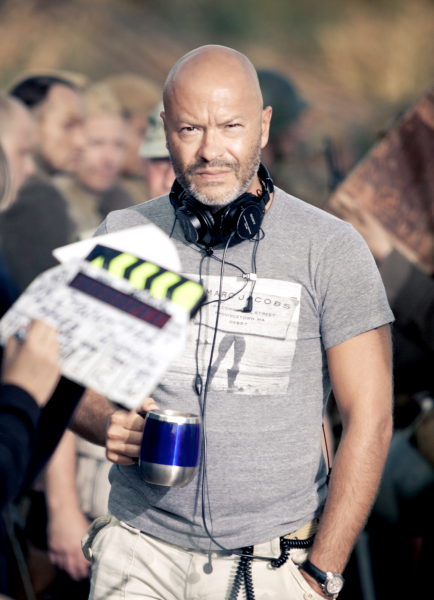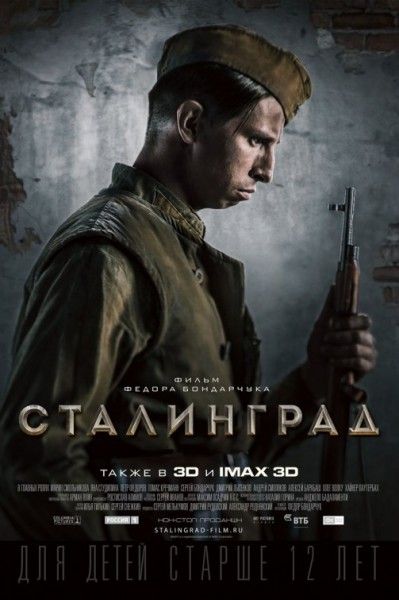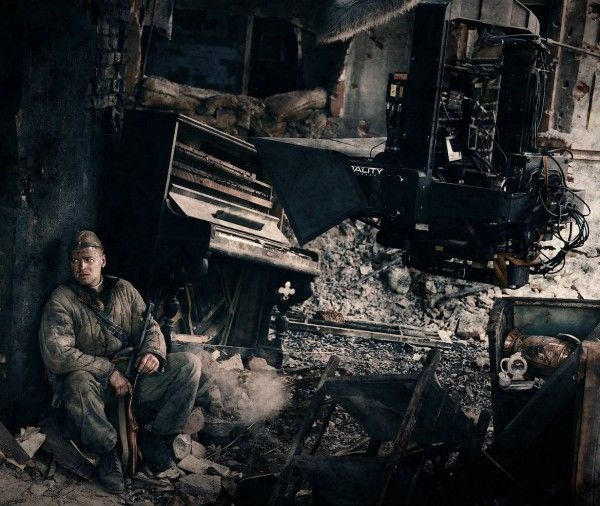Opening in the U.S. in February, Stalingrad is Russia’s official entry for the 86th Academy Awards and the first Russian motion picture to be presented in IMAX 3D. The film tells the epic story of the 1942 battle on the bank of the Volga River that changed the course of World War II and the people who managed to preserve their humanity under inhuman conditions. Directed by Fyodor Bondarchuk, the drama stars Thomas Kretschmann, Yanina Studilina, Philippe Reinhardt, Heiner Lauterbach, Pyotr Fyodorov, Mariya Smolnikova, Aleksey Barabash, Andrey Smolyakov, Sergey Bondarchuk, Dmitriy Lysenkov, Oleg Volku, and Yuriy Vladimirovich Nazarov.
In an exclusive interview, Bondarchuk and producer Alexander Rodnyansky talked about what inspired them to tell a traditional World War II story in a new and visually powerful way with IMAX 3D, how they worked with a talented ensemble of actors to bring the story to life, the unique production challenges they encountered, why they chose to erect a large-scale set to serve as Stalingrad in the suburbs of St. Petersburg, their collaboration with a team of American 3D supervisors and stereographers, and their excitement at having the film selected as the official Russian entry in the Best Foreign Language Film category of the Oscars. Hit the jump to read the interview.
QUESTION: What was it like bringing this story to life on screen with such a talented group of actors?
FYODOR BONDARCHUK: I have always tried to work with first-time actors since my first movie. I always like to do movies with debutants. I prefer, and it turns out to be the truth, that I always have in my movies an ensemble of actors, but not just one individual doing the whole movie. That is why we have a very unusual combination of actors in this movie. On the one side, we have the Germans identified by the German officer, Peter Kahn, beautifully played by Thomas Kretschmann, and his love story with the Russian girl called Masha (Yanina Studilina). On the other side, we have not the individual but a group of people, the ensemble of five people (Pyotr Fyodorov, Sergey Bondarchuk, Andrey Smolyakov, Dmitriy Lysenkov, Aleksey Barabash) around the one Russian girl, Katya (Maria Smolnikova). It’s not the traditional protagonist and antagonist structure.
What were some of the challenges you encountered telling a World War II story in 3D?
BONDARCHUK: It’s very hard to admit that the choice of technology can play such an important role for the director while he’s thinking about the movie. But, in my case, it did play a big role. After I saw Avatar, it made me think about a completely new kind of movie which I had always wanted to do. The technology which is always a part, or let’s say an attribute of all sci-fi/fantasy movies or family-oriented tent poles or cartoons is not the usual choice for a World War II drama. It was very new, and being very new, it was very provocative, because the World War II subject, that theme, is pretty much conservatively treated in Russia. It’s absolutely sacred. Also, there were so many masterpieces by different directors done in the 60s and 70s, it’s considered to be absolutely off limits to any modern experiments or new cinematic language. So, to do a World War II movie in IMAX could have been, and it was in the beginning, considered as an idea to use [gimmicky technology] on a sacred subject to make it more entertaining which is definitely not good. Any attempt to do a World War II movie in a new form, whatever it is, whether cyberpunk animation or some kind of fake history story, something similar to Inglorious Basterds, let’s say, will flop in Russia. We’re talking about Russian cinema. It’s very conservative. That’s why the basic idea was to bring together the traditional filmmaking and a new visual cinematic language to make everyone feel completely different in the space created by the filmmakers and to forget about the glasses and leave all circumstances behind to be a part of the story.
What were some of the advantages and appeal of shooting your film in 3D to tell this story?
BONDARCHUK: There are two different ways to treat 3D. One way is to buy a ticket and you explore the same feelings as you do in any theme park like Universal Studios or Disneyland. The second option is to bring the viewer closer to the events which in our case were in 1942. We wanted to bring them closer. That was the only reason for us to use 3D, not to simply entertain or scare an audience, but to make them feel they are immersed in the story. That’s why we love so much the examples of the films which manage to bring together completely different traditions and genres of the cinema, which are, of course, Gravity or Life of Pi, or Pina, the documentary by Wim Wenders on Pina Bausch, or Cloud Atlas. That was very unusual which for us -- and we have discussed this many times -- it made everyone believe that that kind of auteur cinema or real drama can return to the screen but now on a completely different cinematic level. We believe it is going on right now. That’s why Stalingrad is a part of this process of developing this kind of movie where you want to tell the serious, contemporary story, but not for television. TV is providing such amazing possibilities today. You have such lively characters, fantastic stories and ambiguous messages, and viewers feel very satisfied. For movies, you need to come up with a movie that is only possible to screen in the theater, which legitimizes the way you watch them. You buy your ticket so you need to get something in exchange for that. It should be a spectacle. That’s why we wanted to do Stalingrad not only as a traditional story but also as a very practical, visually powerful movie.
You shot a very complicated film in 3D in 79 days, much of it on location on a large set you erected in the suburbs of St. Petersburg that served as several blocks of Stalingrad. Is there anything you wish you’d known on day one when you first started shooting?
BONDARCHUK: When we started our tests, because we wanted to test the 3D first, after three days of tests, I said we would never ever make this movie in 3D because we would not be able to follow the schedule. In one week, I forgot about the technical aspect of this process and I decided that we should construct the entire set. It was not just drawn. It was erected not far from St. Petersburg. We wanted to do it next to St. Petersburg because it’s one of the two film capitals in our country and so many film professionals live there. Most importantly, we wanted to create a specific atmosphere. Everyone knows that St. Petersburg is a very northern city, and we would expect the sky to be gray and very low as we say, and so that would help us to create the specific atmosphere. Unfortunately, it’s hard to imagine, but we had 70 days of similar sun as what we have right now (here in Los Angeles). We came there to experience gray sky and we found sunny weather in a northern city. So, technically, on the one hand, we had the difficulties of 3D, and on the other hand, we had this weather problem, and that’s how we spent those 70-something days there. It was also during a sports competition, so it was not so easy.
How was your collaboration with the team of American 3D supervisors and stereographers who helped advise you on the technology?
BONDARCHUK: Of course, American filmmakers and professionals are quite different from European ones, not by the structure of the production but by the way that they work. They look very similar to us and to what we are doing in Russia. So, if you need to skip lunch and continue to work, there is no question. You keep on going. If they feel themselves involved in something special, if they believe in the movie, if they enjoy the fact that they are a part of the process, they become obsessed, and because they are very obsessed with their 3D technology, they felt their contributions were important. We were absolutely fortunate to have them. We were lucky and very happy to work with them.
How did the final film compare to what you’d originally envisioned?
BONDARCHUK: On the one hand, of course, there is something I would have improved as always and changed a bit, but it’s not good to say right now after all the success of this movie, and that’s why we have never expected this movie to play so well and to provoke so many discussions. It actually has already become not just a cinematic event but a rather public event because everyone is discussing it, and even if it polarizes some audiences, the lion’s share of viewers at least in Russia loved the film.
How do you feel about your film being selected as the official Russian entry in the Best Foreign Film category of the 86th Academy Awards?
ALEXANDER RODNYANSKY: Of course, we are excited, especially considering how competitive it is with the national Oscar committee considering all entries, specifically in film countries like Russia where you already have 150 movies produced for theatrical distribution every year. It’s very competitive to get one entry. When you know how many people influence a decision, it should be something really special to get your movie selected and entered. That’s why we’re absolutely excited to get our movie selected and we are ready to explore the opportunity. We love the idea of this movie being distributed in the U.S. and across different territories. Sony is doing an amazing job supporting us on this movie in a way we’ve never experienced before, I can tell you. It’s going to open in the U.K., Germany and Poland and the U.S. in February. They will definitely let everyone know when. For us, it’s important. We consider this campaign also a way to inform a part of the audience about this film coming out. We understand an American audience doesn’t like subtitled movies as much as we do, but this is the only way to make it possible for some people outside of the country see this.




